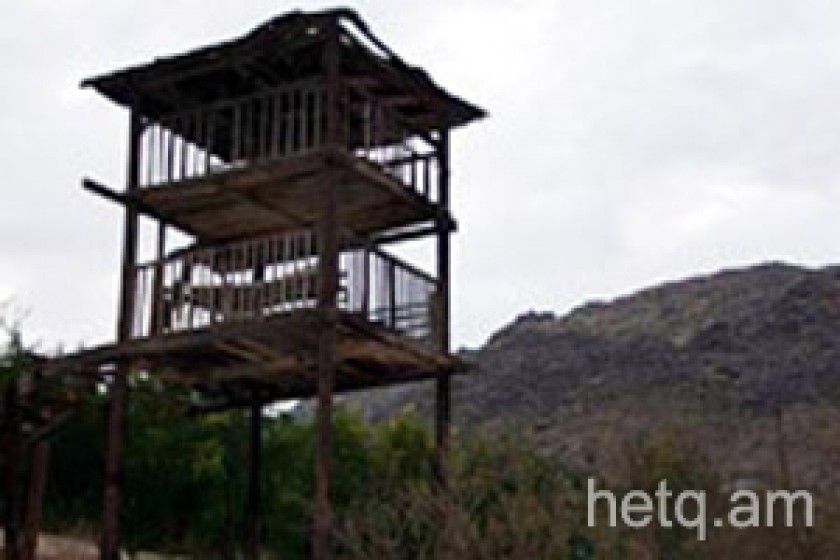
The Border Village of Nrnadzor
During the Soviet era, Azeris exclusively inhabited the village of Nrnadzor, located in the Syunik marz. At the time the village was called Nyuvadi and straddled the border with Iran and Azerbaijan. With the outbreak of the Artsakh war, Armenian forces were able to liberate this Armenian settlement. Today it borders both Iran and the Republic of Nagorno-Karabakh.
“My eldest son was one of the first to come to Nrnadzor in 1991. We lived in Meghri at the time. Two years later he was called-up for military service. He returned to Nrnadzor even after the army was demobilized.
Soon afterwards, we moved the entire family here”, relates Grigor Boyajyan. He has three children and grandchildren. The youngest of his sons will soon marry as well.
There are 47 families residing in Nrnadzor comprising a total population of 145 residents. Eighteen of the families were forcibly evicted from Getashen. The rest have relocated here from various regions in Armenia.
“In the beginning things were quite difficult. When the Azeris were here there was no arable land. Today, thank God, we have water to irrigate the land and we work the fields in the normal manner. Our family has rented seven hectares of land. We raise pomegranates, apricots, mulberries, grapes...the works. Given present conditions we harvest some twenty tons of pomegranates alone”, says G. Boyajyan, pointing to his two-story house undergoing repairs. Look, I’m refitting all the windows with Euro fixtures and building a shower and bathroom lined with tiles. I’m buying two cars, a satellite dish, a music center...not bad for a village like this, no?”
The residents of Nrnadzor have a herd of 110 large animals, but they mainly engage in agriculture. There’s 78 hectares of arable land. Most of the land devoted to raising pomegranates. Last year the village was able to export some 220 tons of pomegranates.
Mkrtich Mkrtichyan, the village mayor, states that,” Up till last year the villager wasn’t being recompensed for his hard work. Factories and traders would come to the village and buy up the pomegranates at cheap prices. The smaller fruit was being bought for 50 drams a kilo. I’d tell both the buyers and villagers that there’d be no pomegranate crop at those prices. Now the smaller ones go for 120-140 a kilo and the larger ones fetch up to 600 drams.”
Not all families in Nrnadzor have it so good.
“Two of our residents are wards of the children’s’ home. They’re single mothers with kids. It’s difficult for these women to work in the fields. They get by tending their small gardens and with other subsidies”, explains the mayor.
“Many just don’t want to work. I remember the time when it was the turn of one of the villagers to receive water to irrigate his plot. The sun’s rays were scorching his field but he stayed at home watching one of those TV serials. It took some effort on my part to get him to work. Alas, the villager wasn’t to blame, but rather the person who turned on the TV.”
Water for irrigation costs 4 drams for every one cubic meter. The mayor notes that he’s gone to the Regional Governor of Syunik to ask if they can be exempted from such fees.
“I would like the water to be distributed free of charge. This way the villagers would become more attached to the land and we’d also be able to bring in people from outside. After all this village safeguards the border”, emphasizes Mkrtichyan.
Sixty percent of Nrnadzor’s populace is young people. The birthrate of the village is rising. This year the newly built school’s first-grade class accepted its first pupil. By next year this number will increase eight-fold.
The mayor recollects when a few families tried to leave the village some 2-3 years ago. “ I blocked the road and stopped them from going. They now realize that I did the right thing, as conditions have gotten better”, he notes.
Nevertheless, there are a number of serious problems inhibiting development in Nrnadzor. There’s no potable water in the village. For years the villagers used to drink water from the Arax River. They’d fill their wells and use the ancient ‘kahrez’ system to clean and distribute it. (A kahrez is an underground water pipe lined inside with stones that connects different veins of water together and brings them to the surface under their own power). This year though the local sanitary station fined the mayor’s office for this practice.
The village is some 30 kilometers from the town of Meghri. The road linking the two communities was built in 1990-1991. This unpaved road is quite dangerous for all those who travel it. Most of the road passes through some deep gorges, which are so narrow that only passenger cars are able to get through.
Mkrtchyan is ready to petition the Governor personally to get some relief.
“ Everything will be set right. There are no unsolvable issues”, says the young mayor with some certainty. He then adds in a half-serious, half-comic manner that, “ Just wait and see. Nrnadzor will become the second capital of Armenia.”
 Videos
Videos Photos
Photos




Write a comment